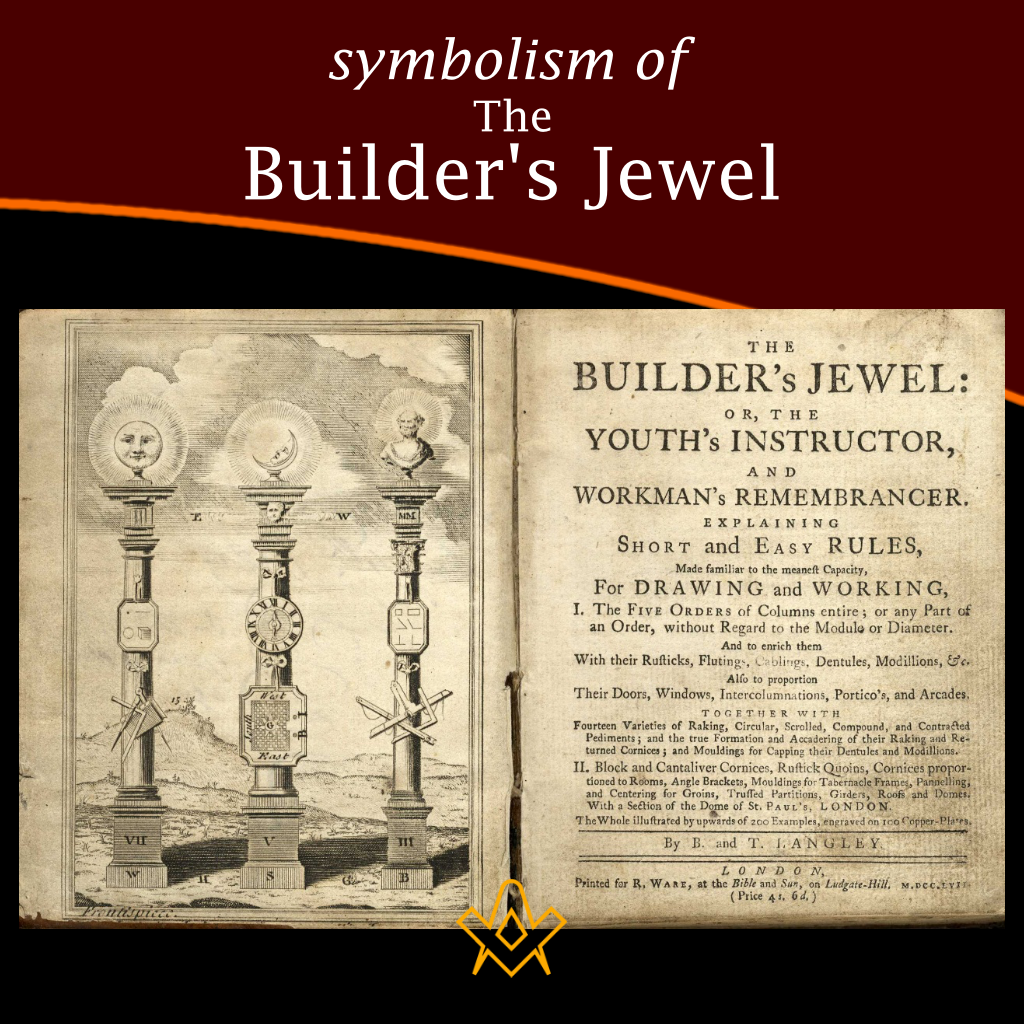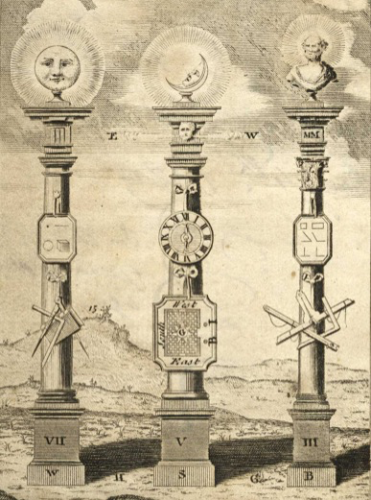The Masonic Symbolism on the Frontispiece to Batty Langley’s The Builder’s Jewel (1741)
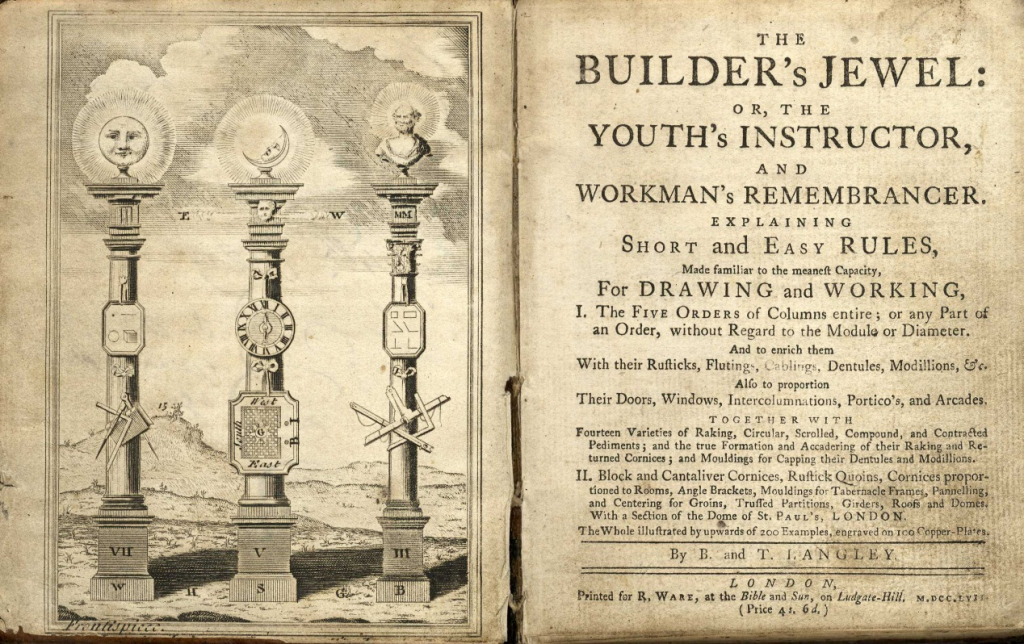
The Masonic Symbolism on the Frontispiece to Batty Langley’s The Builder’s Jewel (1741)
IMAGE LINKED: wikimedia Attribution 4.0 International (CC BY 4.0)
It has never been established when or where Batty Langley (1696-1751) was initiated into the Craft (Freemasonry), but it is known that the garden designer, pattern book publisher and Gothic architect [1] possessed an intimate knowledge of Masonic lore and its symbolism. [2]
Langley, for example, published regularly in the Grub Street Journal[3] under the pseudonym of ‘Hiram’, the legendary architect of Solomon’s Temple and a central figure in Masonic ritual (Langley named one of his children after ‘Hiram’).
Langley’s commitment to Freemasonry, its values and beliefs, were to find visual expression most fully on the frontispiece to The Builder’s Jewel of 1741, a piece of art which contained much of the known symbolism associated with the first three degrees of Freemasonry at the time. [4]
Other titles of Langley’s books influenced by Freemasonry included Practical Geometry (which he dedicated to Lord Paisley, Grand Master of the Freemasons) [5] in1726 and Ancient Masonry (dedicated to a host of known Freemasons, including Francis, Duke of Lorraine, the first recognised Royal Freemason) between 1733 and 1736. [6]
IMAGE LINKED: wikimedia Attribution 4.0 International (CC BY 4.0)
The Builder’s Jewel…or the Youth’s instructor, and Workman’s remembrancer. Explaining short and easy rules, made familiar to the meanest capacity, for drawing and working…. Etc’ was published by R. Ware in London on 26 May 1741, with an initial print run of 2000 copies. [7]
The frontispiece was designed by Batty Langley and engraved by his brother, Thomas Langley (1702-1751). It is signed ‘Batty Langley Invent A L 5741’. This date refers to the Masonic calendar which dates the creation of the Earth to 4000 BC.
Freemasons often dated significant events by adding 4000 years onto the date, thus the date of the frontispiece of 5741. The letters ‘A’ and ‘L’ are short for the Latin words ‘Anno Lucis’ meaning ‘in the year of light’ referring to the year of Creation. [8]
Nearly all the Masonic symbolism present on the frontispiece to The Builder’s Jewel can be found within Samuel Prichard’s Masonry Dissected published in 1730.
This Masonic ‘disclosure’ listed the ritual for the Apprentice, Fellow-Craft and the recently created ‘Master Mason’ or ‘Hiramic’ Degree, with its author claiming to have recently belonged to the brotherhood.
Masonry Dissected also includes one of the earliest known uses of the letter G within Freemasonry, together with early references to the murder of the architect of Solomon’s Temple, Master Hiram Abiff.
The Masonic symbolism of the frontispiece of The Builder’s Jewel was the content of Masonry Dissected in complete visual form.
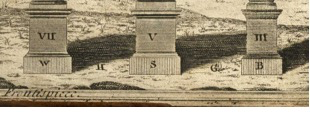
The three pillars [9] illustrated on the frontispiece of The Builder’s Jewel are in order (from left to right), the Roman Doric, [10] Tuscan and Corinthian.
On the dado of the pedestal of each pillar are inscribed the Roman numerals VII, V and III. These are three of the most important numbers in Freemasonry and together equal fifteen.
In some depictions of the spiral staircase that connected the ground floor to the inner chamber of King Solomon’s Temple, the staircase is shown as comprised of fifteen steps (sometimes these steps are shown divided into groups of 3, 5 and 7.
This concept is also illustrated on the frontispiece to The Builder’s Jewel in the form of a hill situated in the background with the number ‘15’ placed on its summit.
The Doric column has the letter ‘W’ inscribed on the plinth of its pedestal, denoting it as exemplifying the virtue of ‘Wisdom’; the Tuscan order with the letter ‘S’, signifying ‘Strength’; and the Corinthian column (or pillar) the letter ‘B’ illustrating the virtue of ‘Beauty’. [11]
In later Masonic depictions of the pillars (particularly with the influence of Neoclassicism), the arrangements of the pillar’s changes from the Roman architectural hierarchy and reverts back to the use of the original three Greek orders with ‘Strength’ associated with the Doric, ‘Wisdom’ now associated with the Ionic, and ‘Beauty’ remaining with the Corinthian. [12]
Between the Doric and Tuscan pillars is placed the letter ‘H’ and between the Tuscan and Corinthian the letter ‘G’. These letters refer to ‘Holy Ground’ as all Masonic lodges were believed to be representations of the Temple of Jerusalem and were symbolically positioned on ‘consecrated ground’. [13]
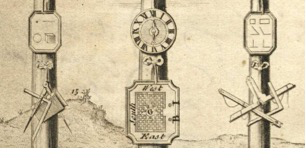
Located towards the centre of each pillar are symbols further associated with architecture and Freemasonry. On the Doric pillar are depictions of the furniture of the lodge, the set-square, compasses and Book of Sacred Law (in Batty Langley’s Christian beliefs, the Bible). [14]
Above these symbols is a panel containing representations of platonic solids including a ‘point, a line, superficies and solid’ (a cube). [15]
On the Tuscan pillar is pinned a representation of the Masonic lodge with its characteristic chequered floor, a reference to ‘duality’ (and a common feature of modern Masonic lodges).
The Temple is orientated to the north where the main entrance is flanked by two pillars labelled ‘B’ and ‘I’. These are representations of the Biblical pillars Iachin and Boaz which stood on the porch to the Temple of Jerusalem. [16]
Three other, secondary entrances are located to the east, south and west. At the centre of the lodge is depicted a seven-pointed ‘Blazing Star’ containing a very early Masonic use of the letter G (possibly indicating Cabalistic influence). [17]
This letter G refers to Geometry (in Freemasonry the fifth of the seven liberal arts, Geometry, is considered the most important).
Located immediately above the Temple plan is a clock face with both hands pointing upwards to numerals XII, indicating ‘high 12 at Noon’.
This alludes to the newly formed Third degree where Hiram Abiff, the architect of Solomon’s Temple, was murdered at the western entrance of the Temple at midday after a failed attempt by three Fellow-Craft masons to retrieve the ‘Mason’s Word’ from the master architect.
The slain architect’s corpse was hidden until dark and his body then moved out of the Temple at Midnight.
On the frieze of this column is a humanised face with wind being blown to the east and west. This is an allusion to the ‘winds of knowledge’ dispersing ‘Masonic truths’. In Freemasonry the east represents the rising sun, enlightenment and birth, and the west with death.
Above the trunk of the Corinthian pillar are the movable jewels of the lodge, the level, square and plumb. Located immediately above is another panel containing various line drawing representations of perpendicular, together with a square and rectangle (or oblong square).
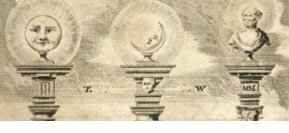
On the abacus of the Doric pillar is positioned a sun; the Tuscan pillar, a moon; and the Corinthian pillar, a bust in a Grecian attire. Taken together the sun, moon and Master Mason (indicated by the initials ‘MM’ located beneath the bust), were known in Masonry Dissected as the three ‘great lights’ of Freemasonry. [18]
It is likely that the identity of the bust is the Greek Polymath Pythagoras, often associated with Euclid, who could legitimately be linked with the Corinthian pillar through his theories on mathematical beauty (Langley also baptised one of his other fourteen children ‘Euclid’).
In addition, the Golden Section and Euclid’s 47th Proposition were important mathematical and practical formulas for Freemasons, as illustrated by the presence of the symbol of the 47th Proposition on the frontispiece engraved by John Pine to Anderson’s Constitutions of the Free-Masons of 1723.
It was often believed by Renaissance architects that numbers possessed mystical characteristics and ‘number magic’ could be detected in the proportions and harmonics of many Renaissance and ancient buildings. [19]
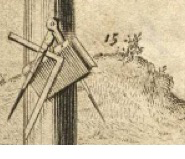
The final and most important pieces of symbolism on the frontispiece of The Builder’s Jewel is also one of the most neglected or overlooked. On the ‘brow of the hill’ in the background is discretely placed the number 15 with a sprig of spiky foliage.
This is a subtle but direct reference to the newly created Hiramic legend which was first disclosed to the public in Samuel Prichard’s Masonry Dissected in 1730. [20]
In this catechism [21] it is described how the Master Architect Hiram Abiff was killed in the Temple at midday by three Fellow-Craft masons who sought to obtain from him the ‘Mason’ or ‘Masters’ word. After the absence of Hiram was noted, King Solomon ordered fifteen masons in three groups of five (3 x 5) to look for the body of the missing architect.
After fifteen days his body was discovered on a ‘brow of a hill’ (the ‘Mossy House’), and Solomon’s masons marked the grave with a ‘cassia’ plant until a decision was made on how to ‘raise’ the badly decomposed body and where it should be buried. [22]
At his funeral fifteen masons were in attendance all dressed in white aprons and gloves before Hiram’s body was interned in the Sanctum Sanctorum within the Temple. [23]
In Langley’s frontispiece the number 15 is visual on the brow of a hill and accompanied by what can be interpreted as a cassia plant.
This is a direct and very early reference to this Hiramic legend which was to form the basis for the ritual of the most important Masonic degree – that of ‘Master Mason’. [24]
Footnotes
Appendix
Symbols on the frontispiece to Batty Langley’s The Builder’s Jewel
1. Roman Doric column/pillar
2. Tuscan column/pillar
3. Corinthian column/pillar
4. Letter ‘H’ denoting ‘Holy’
5. Letter ‘G’ denoting ‘Ground’
6. Roman numeral VII (7)
7. Roman numeral V (5)
8. Roman numeral III (3)
9. Letter ‘W’ denoting ‘Wisdom’
10. Letter ‘S’ denoting ‘Strength’
11. Letter B’ denoting ‘Beauty’
12. Crest of a hill (symbolic ladder)
13. Number 15 on the crest of the hill.
14. Sprig of cassia
15. Compasses
16. Set-square (x2)
17. Book of Sacred Law
18. Dot
19. Line
20. Sphere
21. Cube
22. Sun
23. Lodge plan
24. East, west and south entrances to Temple
25. Mosaic pavement
26. Blazing star
27. The letter ‘G’ representing ‘Geometry’.
28. Letter I denoting Iachin
29. Letter J denoting Jachin
30. Clock face with hands pointing to midday
31. Humanised face blowing winds east and west
32. Moon
33. Set-square.
34. Level
35. Plumb
36. Symbol for square
37. Symbol for rectangle
38. Acute angle
39. Obtuse angle
40. 180° angle
41. 90° angle
42. ‘MM’ denoting ‘Master Mason’
43. Bust of philosopher (Pythagoras?)
References
Footnotes
[1] “A veil should be drawn over (Langley’s) own architectural efforts, but his importance as an influence on Georgian architecture cannot be overestimated.”
(James Stevens Curl, Oxford Dictionary of Architecture, Oxford: Oxford University Press, 1999, p. 371).
[2] For Langley and his Masonic associations, see Eileen Harris, ‘Batty Langley: A Tutor to Freemasons (1696-1751)’, (The Burlington Magazine, Vol.119, No 890, May 1977), pp. 327-333, 335.
[3] Langley used this position to launch vicious attacked on the likes of James Ralph and Neo-Palladians such as William Kent who operated within the Burlington circle. (E. Harris, ‘Batty Langley’, 1977, p. 331-32).
[4] These being the Apprentice, Fellow-Craft and the new Master Mason degree.
[5] “Freemasonry for (Langley) was not the first but the final cause which gave credit to his industry…. Without it he would have been little more than a hack order-monger. Instead, he was, in his own estimation at least, an apostle, a defender and spokesman for the Crafts” (Eileen Harris, ‘Batty Langley’, 1977, p. 239).
[6] Langley had his own building studio where he taught students the rudiments of design. Joseph Rykwert also argues that it may have been used as a Masonic lodge (J. Rykwert, The First Moderns. The Architects of the Eighteenth Century, London: MIT Press, 1983, p.190).
[7] So popular was The Builder’s Jewel that it was republished in fourteen subsequent editions. That the frontispiece was well known internationally is attested to by a tracing board dating from the beginning of the nineteenth century from Hobard, New York, that takes the three columns and much of the basic symbolism from Langley and incorporates them into its own design (however, all references to the death of Hiram (apart from the setting maul) have been expunged and other symbols, such as Jacob’s Ladder and pot of incense, added).
[8] Another example of this use of dating can be found in the title page to James Anderson’s Constitutions of the Free-Masons of 1738.
[9] In this paper I refer to the shafts and their capitals at pillars, but they are more correctly columns as on this frontispiece they are intended to be decorative, and their prime purpose is not to help support and distribute the weight of a structure above such as an entablature. In many Masonic descriptions the distinction is either not recognised or ignored and are almost universally termed pillars, a term I employ for the remainder of this essay.
[10] The Greek Doric was usually baseless.
[11] For example, the three great pillars appear in the catechism of Masonry Dissected of 1730.
Q. How is yr lodge supported?
A. By three great Pillars.
Q. What do they signify?
A. Wisdom to Contrive, Strength to Support and Bea(u)ty to Adorn.
[12] In the lodge the Ionic pillar is identified with the Master, with Doric with the Senior Warden and the Corinthian with the Junior Warden.
[13] This is made clear in Masonry Dissected of 1730.
[14] These would later be known as the three ‘Great Lights’ of Freemasonry.
[15] In his book Symbolism in Craft Freemasonry, the author Colin Dyer states that the progression from a point is to a particular end- the formation of a cube. Dyer explains that ‘the cube is a body composed of six equal sides with all its angles right angles, a symbol of perfection’. Through his Masonic education the Freemason strives to become the perfect ashlar block and with it a fully formed individual and useful member of society. The progression of mathematical symbols also complements the panel opposite on the trunk of the Corinthian pillar with depict angles and perpendiculars.
[16] Until the middle of the eighteenth century these two words were Masonic passwords for identification but were substituted for new words when disclosed to the public by Samuel Prichard in his Masonry Dissected in 1730. See Prichard, Masonry Dissected, 1730, pp. 18, 20, 25.
[17] Questions relating to the form of the Temple and its furniture can also be found in the Entered Apprentice Degree Ritual:
Q. ‘Have you any furniture in your lodge’?
A. ‘Yes’.
Q. ‘What are they’?
A. ‘Mosaick Pavement, the Ground Floor of the Lodge, Blazing Star in the Centre, and indented Tarsel the Border round about it’. (Prichard, 1730, p.13). For the letter G in early Masonic ritual, see Masonry Dissected (1730) and the very similar Wilkinson Manuscript dated to 1727 but possibly later.
[18] Q: ‘What do you see when you was Introduc’d into the Lodge’?
A: ‘Three great lights’
Q: ‘What do they Represent’?
A: Sun, Moon and Master Mason’.
From Masonry Dissected (1730).
[19] For example, see George Hersey, Pythagorean Palaces. Magic and Architecture in the Italian Renaissance (London: Cornell University Press, 1976). Also see Vaughan Hart, Art & Magic in the Court of the Stuarts (London: Taylor & Francis, 2002).
[20] For the Hiram legend represented in the visual arts at the time, see Ricky Pound, ‘The Master Mason Slain: The Hiramic Legend in the Red Velvet Room at Chiswick House’ in Richard Hewlings (ed.), English Heritage Historical Review, (Bristol: English Heritage, 2009), pp.154-163.
The possibility must be considered that this disclosure was deliberate, and by Grand Lodge itself in order to quickly disseminate the new ritual to a wider Masonic audience. Langley must also be considered a likely candidate for penning Masonry Dissected, in particular as he used to write under different names, including Hiram. The frontispiece to The Builder’s Jewel with its concentration of Masonic symbolism may be an allusion to his authorship of Masonry Dissected.
[21] For the full story of the murder of Master Hiram Abiff and his journey to his final resting place see Samuel Prichard, Masonry Dissected, (London, 1730), pp. 25-31. Also see David Stevenson, The Origins of Freemasonry. Scotland’s Century, (Cambridge: Cambridge University Press, 1988), pp. 144-46, 149-150, 160-61; Joannes Snoek, ‘The Evolution of the Hiramic Legend in England and France’ in Heredom 11, (2003), pp. 1-44.
[22] Following several unsuccessful attempts to lift the cadaver, Hiram’s corpse was finally ‘raised’ by a Masonic grip known as the ‘Five Points of Fellowship’- ‘Hand to Hand, Foot to Foot, Cheek to Cheek, Knee to Knee and Hand in Back’ (Prichard, 1730, p. 28).
[23] In several Masonic catechisms the body of Hiram is buried in the lodge next to the Temple on the forecourt between the two Solomonic pillars. Although much of the Masonic symbolism on The Builder’s Jewel was contained within the so-called Wilkinson Manuscript of 1727, the number 15 is not mentioned. This suggests therefore that the frontispiece of The Builder’s Jewel was based solely on that of Masonry Dissected.
[24] The first visual representation of the newly created Hiramic legend appears in the Red Velvet Room ceiling by William Kent at Chiswick House (c. 1729). Here a supine bust of Inigo Jones (architect of King James I, the ‘British Solomon’) has a chisel and setting maul next to him underneath which an acacia plant is placed. He is positioned between two columns and looks with lifeless eyes beyond a blazing star to the figure of Hermes who is suspended in the air in front of a zodiacal wheel containing the zodiac signs Gemini and Virgo, tutelary bodies for the planet Mercury. See Ricky Pound, ‘The Master Mason Slain: The Hiramic Legend in the Red Velvet Room at Chiswick House’ in Richard Hewlings (ed.), English Heritage Historical Review, (Bristol: English Heritage, 2009), pp.154-163.
Associated Sources
Associated Sources / Additional Reading
Curl, James Stevens, The Art and Architecture of Freemasonry (London: Batsford Press, 1991)
Curl, James Stevens, Oxford Dictionary of Architecture (Oxford: Oxford University Press, 1999)
Dyer, Colin, Symbolism in Craft Freemasonry (Shepperton: Lewis Masonic Ian Allan Regalia Ltd, 1983).
Harris, Eileen, ‘Batty Langley: A Tutor to Freemasons (1696-1751)’, (The Burlington Magazine, Vol.119, No 890, May 1977).
Hersey, George, Pythagorean Palaces. Magic and Architecture in the Italian Renaissance (London: Cornell University Press, 1976).
Rykwert, Joseph, The First Moderns: The Architects of the Eighteenth Century (United States: The MIT Press, 1983).
Langley, Batty, Langley, Thomas, The Builder’s Jewel; Or, The Youth’s Instructor And Workman’s Remembrancer: Explaining Short And Easy Rules Made Familiar To The Meanest Capacity For Drawing And Working (London, R. Ware, 1741).
Lovegrove, Henry, ‘Batty Langley on Geometry’ in Ars Quatuor Coronatorum 11 (18): pp.134-36.
Macpherson, Jay, ‘Jachin and Boaz and the Freemasons’ in B. Scholz, M. Bath & D. Weston (eds.), The European Emblem: Selected Papers from the Glasgow Conference11-14 August 1987 (Boston: Brill Publishing, 1990), pp. 134-6.
Pound, Ricky, ‘The Master Mason Slain: The Hiramic Legend in the Red Velvet Room at Chiswick House’in Richard Hewlings (eds.), English Heritage Historical Review (Bristol, 2009), pp.154-63.
Prichard, Samuel, Masonry Dissected: Being A Universal and Genuine DESCRIPTION of All its Branches from the Original to this Present Time. As it is deliver’d in the Constituted Regular Lodges Both in the CITY and Country, According to the Several Degrees of ADMISSION. (London, 1730).
Ress, Julian, Tracing Boards of Three Degrees in Craft Freemasonry Explained (London: Lewis Masonic, 2009).
Snoek, Joannes, ‘The Evolution of the Hiramic Legend in England and France’ in Heredom 11, (2003), pp. 11-53.
Stevenson, David, The Origins of Freemasonry. Scotland’s Century 1590-1710 (Cambridge: Cambridge University Press, 1988).
Text by Ricky Pound. Revised 22/05/2023
Article by: Ricky Pound
Recent Articles: symbolism
 Legends and Symbols in Masonic Instruction Explore the significance of Masonic legends and symbols in this insightful post. Discover how Freemasonry imparts wisdom through allegorical narratives and emblematic imagery, revealing profound moral and philosophical lessons. Unveil the deep connections between Masonic teachings and the broader quest for understanding life’s fundamental questions. |
 Discover the mystical significance of the number 33. From its mathematical marvels and artistic influence in numerology to its esteemed place in Freemasonry, delve into the history and power of this master number. Explore why 33 holds such profound meaning in various spiritual and philosophical traditions. |
 The Practice of Freemasonry - P1 Embark on a transformative journey with Freemasonry, where the exploration of your Center unlocks the Perfect Ashlar within. Through the practices of Brotherly Love, Relief, Truth, and Cardinal Virtues, discover a path of enlightenment and self-improvement. Embrace the universal creed that binds us in the pursuit of our true essence. |
 Discover the fascinating history and significance of the Warrant of Constitution within Freemasonry. Unveil the evolution of this crucial authorization, its role in legitimizing Lodges, and its lasting impact on the global brotherhood of Freemasons. Explore the intricate link it provides between tradition and modern practice. |
 Freemasonry: Unravelling the Complexity of an Influential Organization Mysterious and captivating, Freemasonry has piqued the interest of seekers and skeptics alike. With its intricate blend of politics, esotericism, science, and religion, this enigmatic organization has left an indelible mark on society. Prepare to delve into the secrets of Freemasonry and unlock its hidden depths. |
 Unlocking the Mysteries of Freemasonry: In the hallowed halls of Freemasonry, a powerful symbol lies at the heart of ancient rituals and teachings—the Volume of the Sacred Law. This sacred book not only guides the spiritual and moral journey of Freemasons but also serves as a beacon of universal wisdom and enlightenment. |
 The Ancient Liberal Arts in Freemasonry Embark on a journey of self-improvement and wisdom with Freemasonry's guiding principles. Ascend the winding stairs of moral cultivation, analytical reasoning, and philosophical understanding. Embrace arithmetic's mystical properties and geometry's universal truths. Let the harmony of the universe inspire unity and growth. Discover the profound, hidden knowledge in Freemasonry's path to enlightenment. |
 Initiation rituals around the world are filled with fascinating elements and different images. One of them is that of darkness. When societies speak of darkness, they often mean a lack of knowledge, a lack of choice, or a symbol of evil. During initiation rituals, darkness is used to represent the initiate's lack of knowledge about the world, society, and initiation in general. It can also represent the initiate's inability to make a choice or endure a situation. Whether you have participated in an initiation rite or not, the meaning of darkness remains an intriguing concept worth exploring. Initiation rituals around the world are filled with fascinating elements and different images. One of them is that of darkness. When societies speak of darkness, they often mean a lack of knowledge, a lack of choice, or a symbol of evil. During initiation rituals, darkness is used to represent the initiate's lack of knowledge about the world, society, and initiation in general. It can also represent the initiate's inability to make a choice or endure a situation. Whether you have participated in an initiation rite or not, the meaning of darkness remains an intriguing concept worth exploring. |
 Masonic Deacon rods potentially trace their origins to Greek antiquity, symbolically linked to Hermes' caduceus. As Hermes bridged gods and mortals with messages, so do Masonic Deacons within the lodge, reinforcing their roles through ancient emblems. This connection underscores a profound narrative, weaving the fabric of Masonic rites with the threads of mythological heritage, suggesting the rods are not mere tools but bearers of deeper, sacred meanings that resonate with the guardianship and communicative essence of their divine counterpart, Hermes, reflecting a timeless lineage from myth to Masonic tradition. |
 The biblical pillars erected by Solomon at the Temple's porch, hold a profound place in history. These brass behemoths are not mere decorations; they are symbols of strength, establishment, and divine guidance. Explore their fascinating construction, dimensions, and the deep meanings they carry in both biblical and Masonic contexts. |
 Unlocking the Mind's Potential: Dive deep into ground breaking research revealing how simple daily habits can supercharge cognitive abilities. Discover the untapped power within and redefine your limits. Join us on this enlightening journey and transform your world! |
 Dive deep into the symbolic importance of the trowel in Masonry, representing unity and brotherly love. From its historical roots in operative masonry to its significance in speculative masonry, this article explores the trowel's multifaceted role. Discover its connection to the sword, the story of Nehemiah, and the Society of the Trowel in Renaissance Florence. Unravel the layers of meaning behind this enduring Masonic symbol. |
 Symbolism of The Builder's Jewel Batty Langley's "The Builder’s Jewel" (1741) is a visual masterpiece of Masonic symbolism, showcasing Langley's deep understanding of Freemasonry. The frontispiece highlights key symbols like the three pillars and the legend of Hiram Abiff, emphasizing Langley's dedication to Masonic traditions and teachings. |
 Unveil the mystique of the colour blue in Masonic symbolism. A hue evoking universal friendship and benevolence, its roots span ancient cultures, infusing Freemasonry's core values. This article explores blue's profound significance, guiding Freemasons towards wisdom and spiritual enlightenment. Discover the fascinating journey of this universal symbol. |
 Discover the intriguing world of the plumb in Masonic symbolism with our in-depth analysis. Uncover its rich history, moral teachings, and significance in Freemasonry, guiding members on their path to truth, integrity, and justice. Immerse yourself in the captivating power of this symbol that shapes lives within the brotherhood. |
 Unlock the mysteries of Freemasonry with 'The Key,' a profound Masonic symbol. This seemingly simple instrument holds a deeper meaning, teaching virtues of silence and integrity. Explore its ancient roots, from Sophocles to the mysteries of Isis, and discover how it symbolizes the opening of the heart for judgment. |
 Unlock the secrets of the Freemasonry with The Blazing Star - a symbol that holds immense significance in their rituals and practices. Delve into its history, meaning and role in the different degrees of Freemasonry with expert insights from the Encyclopedia of Freemasonry by Albert Mackey. Discover the mystique of The Blazing Star today! |
 There is no symbol more significant in its meaning, more versatile in its application, or more pervasive throughout the entire Freemasonry system than the triangle. Therefore, an examination of it cannot fail to be interesting to a Masonic student. Extract from Encyclopedia of Freemasonry by Albert Mackey |
 The Hiramic Legend and the Myth of Osiris Hiram Abiff, the chief architect of Solomon’s Temple, is a figure of great importance to Craft Freemasonry, as its legend serves as the foundation of the Third Degree or that of a Master Mason. He is the central figure of an allegory that has the role of teaching the Initiate valuable alchemical lessons. Although his legend is anchored in biblical times, it may have much older roots. |
 This rite of investiture, or the placing upon the aspirant some garment, as an indication of his appropriate preparation for the ceremonies in which he was about to engage, prevailed in all the ancient initiations. Extract from The Symbolism of Freemasonry by Albert G. Mackey |
 The All-Seeing Eye of God, also known as the Eye of Providence, is a representation of the divine providence in which the eye of God watches over humanity. It frequently portrays an eye that is enclosed in a triangle and surrounded by rays of light or splendour. |
 What's in a Word, Sign or Token? Why do Freemasons use passwords, signs, and tokens? As Freemasons we know and understand the passwords, signs and tokens (including grips), which are all used a mode of recognition between members of the fraternity. |
 A Temple of Living Stones: Examining the Concept of a Chain of Union What are the origins of the Chain of Union? And how did they come about ? The answers may surprise some members as W Brother Andrew Hammer investigates, author of Observing the Craft: The Pursuit of Excellence in Masonic Labour and Observance. |
 One of the best loved stories for the festive season is ‘A Christmas Carol’. A traditional ghost story for retelling around the fire on a cold Christmas Eve, it is a timeless classic beloved by those from all walks of life. Philippa explores the masonic allegory connections… |
 The Trowel - Working Tool of the Master Mason The Trowel is the symbol of that which has power to bind men together – the cement is brotherhood and fellowship. |
 Two Perpendicular Parallel Lines The point within a circle embordered by two perpendicular parallel lines, with the Holy Bible resting on the circle, is one of the most recognizable symbols in Freemasonry. It is also one which always raises a question. How can two lines be both perpendicular and parallel? |
 "The first great duty, not only of every lodge, but of every Mason, is to see that the landmarks of the Order shall never be impaired." — Albert Mackey (1856) |
 It is common knowledge that the ancient wages of a Fellowcraft Mason consisted of corn, wine, and oil. |
 “Do not come any closer,” God said. “Take off your sandals, for the place where you are standing is holy ground.” Exodus 3:5 |
 The Secret Language of the Stone Masons We know of Masons' Marks but lesser known are the 'argots' used by the artisans - in part 2 of a series on the social history of the Operative Masons we learn how the use of secret languages added to the mystery of the Guilds. |
 The phrase appears in the Regius Poem. It is customary in contemporary English to end prayers with a hearty “Amen,” a word meaning “So be it.” It is a Latin word derived from the Hebrew word - Short Talk Bulletin - Vol. V June, 1927, No.6 |
 Egypt's 'Place of Truth' - The First Operative Stone Masons' Guild? Was ancient Egypt's 'village of the artisans' the first operative stone masons' guild? And was their use of 'identity marks' a forerunner of the Mason's Marks of the cathedral builders of the Middle Ages? Read on for some possible answers… |
 The Pieces of Architecture and the Origin of Masonic Study Discover the journey of the Apprentice – from Operative to Speculative. This journey has been carried out since the times of operative Freemasonry but today the initiate works in the construction of his inner temple. |
 The Builders' Rites - laying the foundations operatively and speculatively The cornerstone (also ‘foundation’ or ‘setting’ stone) is the first stone to be set in the construction of the foundations of a building; every other stone is set in reference to this. |
 Applying the working tools to achieve our peculiar system of morality. |
 We take an in-depth look at the 47th Proposition of the 1st Book of Euclid as part of the jewel of the Past Master. |
 The Cable Tow: Its Origins, Symbolism, & Significance for Freemasons - Unbinding the significance of the cable tow. |
 We examine at one of the most impressive moments of the initiatory ceremony, a certain rite known as Circumambulation, and ask what is its meaning and purpose ? |
 So, what is the Level? And why do we use it in Freemasonry? |
 What is the mysterious pigpen or Masonic cipher that has been used for centuries to hide secrets and rituals? |
 The Story of the Royal Arch - The Mark Degree Extracted from William Harvey's 'The Story of the Royal Arch' - Part 1 describes the Mark Degree, including the Working Tools. |
 Ashlars - Rough, Smooth - Story of a Stone How we can apply the rough and smooth Ashlars with-in a masonic context |
 A detailed look at the Chamber of Reflection: A Revitalized and Misunderstood Masonic Practice. |
 Exploring the origin and symbolism of Faith, Hope and Charity |
 The Noachite Legend and the Craft What is it to be a true Noachidae, and what is the Noachite Legend and the Craft ? |
 In Masonic rituals, Jacob’s ladder is understood as a stairway, a passage from this world to the Heavens. |
 What is the meaning of the Acacia and where did it originate ? |
 What is the connection with the Feasts of St John and Freemasonry |
 The Forget-Me-Not and the Poppy - two symbols to remind us to 'never forget' those who died during the two World Wars. |
 Biblical history surrounding the two pillars that stood at the entrance to King Solomon's Temple |
 Is there a direct link between Judaism and Freemasonry? |
 The symbolism of the beehive in Masonry and its association with omphalos stones and the sacred feminine. |
 The Wages of an Entered Apprentice |
 An explanation of the North East corner charge which explores beyond one meaning Charity - |
 A brief look at the origins of the two headed eagle, probably the most ornamental and most ostentatious feature of the Supreme Council 33rd Degree Ancient and Accepted (Scottish ) Rite |
 A Muslim is reminded of his universal duties just as a Freemason. A Masonic Interpretation of the Quran's First Two Chapters |
 The three Latin words -{Listen, Observe, Be Silent}. A good moto for the wise freemason |
masonic knowledge
to be a better citizen of the world
share the square with two brothers

click image to open email app on mobile device
